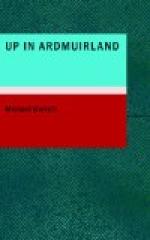II
MEMORIES
“Remembrance wakes with all her
busy train,
Swells at my breast, and turns the past
to pain.”
(Goldsmith—“Deserted
Village")
I have heard a complaint made of some reverend preachers (untruthfully, I well believe) that they could never begin a sermon without harking back to the Creation. Now it is not my intention to travel quite so far back into the past, but I must confess to a desire to dig somewhat deeply into the history of Ardmuirland in days gone by before touching upon more recent happenings. Such a desire led me to investigate the recollections of some of our “oldest inhabitants.”
Willy Paterson, I well knew, was to be trusted for accurate memories of a certain class of happenings; but for more minute details of events the feminine mind is the more reliable. So I determined to start with Willy’s wife, Bell. Their dwelling is nearest to ours; it stands, indeed, but a few yards down the road which leads past our gate. It is a white-walled, thatched house of one story only—like most of the habitations in Ardmuirland; it stands in a little garden whose neatness and the prolific nature of its soil are standing proofs of Willy’s industry in hours of leisure.
Owing to the prevalence in our neighborhood of some particular patronymics—Macdonald, Mackintosh, Mackenzie, and the rest—many individuals are distinguished by what is called in Ardmuirland a “by-name.” Some of these are furnished by the title of the residence of the family in question, others by the calling or trade of father, mother, or other relative; thus we have “Margot of the Mill,” “Sandy Craigdhu,” as examples of the former, and “Nell Tailor,” “Duncan the Post,” of the latter. Still more variety is obtained by the mention of some personal trait of the individual, such as “Fair Archie,” “Black Janet,” and the like. Willy Paterson’s wife was commonly known by such a by-name; every one spoke of her as “Bell o’ the Burn,” from the name of her childhood’s home.
Bell is a spare, hard-featured body—not attractive at first sight, though when one comes to know her, and the somewhat stern expression relaxes, as the lines about the mouth soften, and the brown eyes grow kindly, one begins to think that Bell must have been once quite handsome. She is always scrupulously clean whenever I chance to visit her, and is usually arrayed in a white “mutch” cap, spotless apron, and small tartan shawl over her shoulders. Willy and she have reared up a large family, all of them now settled in the world and most of them married. They are most proud of their youngest, Margaret, who is a lay sister in a town convent. Though her husband is reckoned a traveler, Bell can lay no claim to the title; she probably never moved farther than ten miles away from the family hearthstone until the day she left her father’s house by the Burn of Breakachy to marry Willy Paterson, and certainly has never traveled much since that time.




